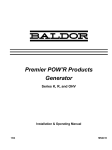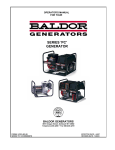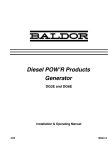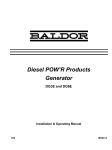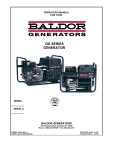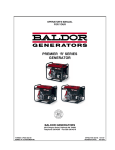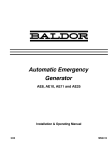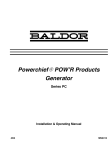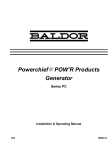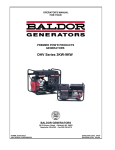Download Baldor Premier 'K' Operator`s manual
Transcript
OPERATOR'S MANUAL FOR YOUR PREMIER ‘K’ SERIES GENERATOR BALDOR GENERATORS 3815 OREGON STREET OSHKOSH WI 54902 Phone: (920) 236-4200 Fax: (920) 236-4219 Toll Free: 800-872-7697 FORWARD This manual contains the information you need to safely and efficiently operate your generator set. During the preparation of this manual every effort was made to ensure the accuracy of its contents. DO NOT OPERATE THIS GENERATOR SET UNTIL YOU CAREFULLY READ THIS MANUAL AND UNDERSTAND THE SAFETY WARNINGS AND INSTRUCTIONS CONTAINED IN IT. While safety is built into every Baldor Pow'R Gard generator set, careless or improper operation could possibly result in mechanical failure, property damage, severe injury or even death. Note that this manual covers only very basic information in regards to the engine. A separate owner's manual for the engine is supplied with this unit for your use. Please refer to this manual for information relative to engine operation, maintenance, recommendations and additional safety warnings. As soon as you receive your generator set, inspect it closely for shipping damage. If you find some damage, notify the transportation company immediately and file a freight damage claim. Think of this manual as a tool to help you get the most out of your generator set. WE STRONGLY SUGGEST THAT YOU KEEP THIS MANUAL WITH YOUR GENERATOR SET AND MAKE IT AVAILABLE TO ANYONE USING THE GENERATOR SET. You should refer to the manual when questions arise in regards to the operation of the generator set and carefully observe all safety warnings and instructions contained in it. Baldor Generators, formerly Pow'R Gard Generator Corporation has been in business since 1965. The generator sets we manufacture have earned the reputation of being of high quality and a dependable product. We take pride in this fact and continue to keep our quality standards high on our list of priorities. We are also constantly researching new technological ideas to determine if they could be used to make our generator sets even better. Thank you for purchasing your Baldor Pow'R Gard Generator Set. -i- ♦ Place protective covers and guards over the rotating parts, if rotating parts such as the drive shaft, pulley, belt, etc. are left exposed, they are potentially hazardous. ♦ When cleaning, repairing or inspecting, make sure all moving parts have stopped. ♦ Prior to working on the generator set, disconnect the spark plug and battery to prevent accidental starting. ♦ Use only original equipment or authorized replacement parts. Use of correct parts will assure the operator of the safety integrity that was designed into the unit. ♦ Unauthorized modifications to the generator set may impair the function and/or safety of the unit. ♦ Do not operate the generator set without a muffler. Inspect periodically and replace if necessary. ♦ Do not touch the hot exhaust components or the high voltage spark plug and coil terminals. While Spark Plug Voltages are not normally lethal, an involuntary jerk of the hand caused by a hot surface or by an electrical shock can result in injury. ♦ Repair of electrical generating equipment requires specialized skills. Repair personnel must have a thorough understanding of generator and small engine repair procedures. ♦ Never inhale exhaust gases. They contain carbon monoxide; a colorless, odorless and extremely dangerous gas that can cause unconsciousness or death. Symptoms of carbon monoxide poisoning can include: dizziness, nausea, headaches, sleepiness, vomiting or incoherency. If you or anyone else experiences any of these symptoms, get out into the fresh air immediately. Shut the unit down and do not operate it until it has been inspected and, if necessary, repaired. ♦ Never Operate the generator set indoors or in a poorly ventilated area such as a tunnel or cave. ♦ CALIFORNIA PROPOSITION 65 WARNING: engine exhaust from this product contains chemicals known to the state of California to cause cancer, birth defects or other reproductive harm. - ii - ♦ Know how to stop the engine quickly and understand the operation of all controls. ♦ Never permit anyone to operate the generator set without proper instructions. ♦ Never allow children to operate the generator set. ♦ Children and pets must be kept away from the area of operation due to the possibility of burns from hot engine components or injury from any equipment the generator set is powering. ♦ Always wear eye protection and Hearing protection when working near the generator set. ♦ Operate the generator set only with the guards, shields and other safety items in place and working properly. ♦ Do not put hands, feet, tools or other objects near rotating parts. ♦ Use reasonable care when moving or lifting the unit. The generator set may move around inside the wrap frame creating "Pinch Points". ♦ Do not run the generator set while it is being moved. ♦ Do not support the generator set from the top of the wrap frame. ♦ Do not operate the generator set while under the influence of alcohol, drugs or medication. ♦ When transporting or using a generator set with the wheel option, secure the unit to prevent it from moving around. ♦ Do not tamper with or change the engine speed as it has been preset at the factory for proper operation. ♦ Keep hands and face away from the carburetor when the air cleaner is being moved. A sudden backfire can cause serious burns. ♦ Be careful of hot parts. The muffler and other generator parts become very hot while the engine is running. ♦ Do not "jump start" the generator set. ♦ Sulfuric acid can cause severe injury and can give off gases, which are corrosive and potentially explosive. Avoid contact with skin, eyes, and clothing. In case of contact, flush area immediately with water. ♦ When transporting a generator set, secure it to prevent it from moving or shifting. ♦ Know how to stop the engine quickly and understand the operation of all controls. ♦ Do not operate electrical equipment while standing in water, on wet ground or with wet hands or shoes. ♦ Use extreme caution when working on electrical components. Potentially dangerous voltage is present when the engine is running. - iii - ♦ Always treat the electrical circuits as if they were energized. ♦ Disconnect all leads plugged into the unit Prior to working on it. ♦ Have the electrical circuits serviced only by qualified technicians. ♦ Inspect wiring frequently and replace frayed, broken or poor leads. ♦ Do not connect this unit to any building's electrical system unless you utilize an approved transfer switch or the main service entrance switch has been disconnected and locked open. ♦ Circuit overload protection must be provided in accordance with national electrical codes and local regulations. ♦ Check GFCI Receptacles monthly by using the "Test" and "Reset" buttons designed into them. ♦ Depending on your application it may be mandatory to ground or not ground this unit to earth ground. Comply with local electrical codes. ○○○○ FOR GASOLINE OR DIESEL POWERED GENERATOR SETS ○○○○ ♦ Operate the generator set on a level surface. If the generator set is tilted, fuel spillage may result. ♦ Handle fuel with care. It is highly flammable. Use only clean, properly marked and approved safety containers for refueling and storing fuel. ♦ Stop the engine and allow it to cool before refueling. ♦ Do not overfill the fuel tank. Only fill the tank to within 1/2" of the top of the tank to allow space for fuel expansion. ♦ If fuel is spilled, wipe it up carefully and wait until the fuel has dried before starting the engine. ♦ Make sure the fuel cap is properly closed after refueling. ♦ Never operate the generator set while smoking. ♦ Never operate the generator set near an open flame. ♦ Never store the generator set with fuel in the tank indoors or in an enclosed, poorly ventilated enclosure where fuel fumes may reach an open flame, electrical spark or pilot light as on a furnace, water heater, clothes dryer, etc. ♦ When transporting over long distances or rough roads, drain the fuel tank to prevent leakage and spillage. - iv - ○○○○ FOR GASOLINE OR DIESEL POWERED GENERATOR SETS ○○○○ ♦ Check all fuel supply piping and their connections on a monthly basis for fuel leaks. ♦ Use only approved piping and componentry in your fuel supply system. ♦ A professional, experienced technician should only install the fuel supply system. ♦ Do not run the fuel line up against any sharp objects. ♦ Comply with NFPA regulations and your local codes in regard to shut-off valves, regulators, etc. and any other recommendations or requirements they may have. ♦ Keep the generator set at least three feet away from buildings or other structures. ♦ Keep the generator set away from flammable and other hazardous materials (trash, rags, lubricants, explosives, paints, etc.) ♦ Keep the generator set free of grass, leaves and excessive grease and oils. ♦ Allow the generator set to cool before transporting it or storing it indoors. ♦ Have fire extinguisher accessible and nearby while operating the generator set. ♦ This generator set must not be used on or near any forest covered brush covered or grass covered land unless the engine's exhaust system is equipped with a spark arrester and it must be maintained in effective working order by the operator. ♦ Operation inside an enclosed compartment or building is a potential fire hazard and should not be done unless approval is obtained from Baldor Generators. Engine/Generator overheating can cause severe damage due to restricted, obstructed or improper air-flow that is necessary for the proper cooling of the unit. ♦ Hot exhaust gases being discharged by the engine must never be directed toward anything that could catch fire or explode. -v- TABLE OF CONTENTS SECTION PAGE Basic Location Information………………………………………………………………………………………….1 Basic Connection Information…………………………………………………………………………………….2 Basic Engine Information……………………………………………………………………………………………….3 Generator End Maintenance…………………………………………………………………………………………….4 Basic Engine Maintenance……………………………………………………………………………………………….5 Storage Information…………………………………………………………………………………………………………….6 Electric Motor Loads………………………………………………………………………………………………………….7 Parts and Service Information………………………………………………………………………………….8 Operation……………………………………………………………………………………………………………………………………….9 Simple Troubleshooting…………………………………………………………………………………………………….11 Control Panel for K3000………………………………………………………………………………………………….14 Control Panel for K5000/K5000E……………………………………………………………………………….15 Control Panel for K6500/K6500E……………………………………………………………………………….16 Wiring Diagram: K3000…………………………………………………………………………………………………….17 Wiring Diagram: K5000/K5000E………………………………………………………………………………….18 Wiring Diagram: K6500/K6500E………………………………………………………………………………….20 Generator End Componentry Diagram……………………………………………………………………….22 Control Box Componentry: Parts Breakdown: All Models……………………………………………………………….23 All Models…………………………………………………………………………………….24 Warranty Information………………………………………………………………………………………………………….25 LOCATION For best service from your portable generator set there are several factors which should be taken into consideration when choosing the best location in which to operate it: MOISTURE: All electrical equipment should be protected from excessive moisture. Failure to do so will result in deterioration of the insulation and may result in short circuits and a possible electrocution hazard. OPERATING ELECTRICAL EQUIPMENT IN WET ENVIRONMENTAL CONDITIONS CREATES A POTENTIAL ELECTROCUTION HAZARD. DO NOT OPERATE ELECTRICAL EQUIPMENT WHILE STANDING IN WATER, ON WET GROUND, OR WITH WET HANDS OR SHOES. DIRT: Foreign materials such as dust, sand and other abrasive materials have a tendency to cause excessive wear to both engine and generator parts. It is important that the unit be operated in a reasonably clean environment. HEAT: All engines give off considerable heat when running. Since the engine and your generator set uses air to keep it cool it is important that the temperature of the area in which it is located is does not exceed 100o F (even while it is running). Where natural ventilation is inadequate a fan to boost circulation should be utilized. EXHAUST: Exhaust Gases from internal combustion engines are extremely poisonous. Whenever an engine is run indoors the exhaust fumes must be vented to the outside. EXHAUST FUMES CAN CAUSE SEVERE INJURY OR DEATH. ALWAYS OPERATE IN A WELL-VENTILATED AREA. CONFINED SPACE: This unit must not be operated in a confined space or an enclosed compartment / area. Running the generator set in this environment is a potential fire hazard and is not authorized. Engine and generator overheating damage could also occur due to restricted cooling airflow to and from the unit. OPERATING THIS UNIT IN AN AREA WITHOUT ADEQUATE VENTILATION CREATES A POTENTIAL FIRE HAZARD. ALWAYS OPERATE THIS UNIT IN A WELL-VENTILATED AREA. -1- CONNECTIONS WIRING: Use sufficiently large insulated wire to connect the generator set to the load. The gauge of the wire will depend largely on the distance, the permissible voltage drop, and the size and type of load. If you are not sure of the gauge wire needed for your application, consult a competent electrician. FRAYED, CUT, BROKEN, LOOSELY CONNECTED, OR IMPROPERLY SIZED POWER CORDS OR WIRES CAN CAUSE EQUIPMENT DAMAGE, FIRE, SEVERE INJURY OR DEATH. INSPECT AND MAINTAIN ALL POWER CORDS ON A REGULAR BASIS. GROUNDING: If grounding is necessary in your application according to National Electric Code and/or local codes, drive a 3/4" or 1" pipe into the ground as close to the generator Set as is possible. This pipe must penetrate moist earth (minimum of 8 feet). Connect a ground clamp to this pipe and run a No. 10 wire or larger from it to the ground stud on the generator set. Do not connect the ground wire from the generator set to a water pipe or a ground used by a radio system. IMPROPER GROUNDING CAN CAUSE EQUIPMENT DAMAGE, SEVERE INJURY OR DEATH. INSPECT AND MAINTAIN THE GROUNDING SYSTEM IN ACCORDANCE WITH ALL APPLICABLE CODES. CONNECTIONS TO HOUSE WIRING: Any electrical generator that is temporarily connected to a building or home (where the building is also supplied electricity by a local utility) shall be connected only by a competent electrician and only after the main service entrance switch has been disconnected and locked open. This will isolate the building's electrical system from the local utility's electrical transmission wires and prevent the hazard of electrical back-feed to utility service workers. Any generator set that is permanently connected to a building or home (where the building is also supplied electricity by a local utility) shall be connected only by means of a double- throw transfer switch. This will isolate the building's electrical system from the local utility's electrical transmission wires and prevent the hazard of electrical back-feed to utility service workers. DO NOT CONNECT THIS GENERATOR SET TO ANY BUILDING'S ELECTRICAL SYSTEM UNLESS YOU USE AN APPROVED TRANSFER SWITCH OR THE MAIN SERVICE ENTRANCE SWITCH HAS BEEN DISCONNECTED AND LOCKED OPEN. ANY TEMPORARY OR PERMANENT WIRING CONNECTIONS MADE BETWEEN A GENERATOR SET AND AN EXISTING ELECTRICAL SYSTEM MUST ONLY BE DONE BY A QUALIFIED COMPETENT ELECTRICIAN. IMPROPER WIRING/ CONNECTIONS COULD CAUSE EQUIPMENT DAMAGE, PROPERTY DAMAGE, INJURY OR DEATH. CHECK ALL NATIONAL ELECTRIC CODES AND ALL LOCAL CODES IN REGARDS TO YOUR SPECIFIC APPLICATION. ANY NATIONAL ELECTRIC CODE OR LOCAL CODE WILL TAKE PRECEDENCE OVER ANY OF OUR GUIDELINES OR RECOMMENDATIONS. -2- ENGINE INFORMATION This operator's manual only covers basic day- to- day engine operating instructions. However, the engine manufacturer's manual is included with your generator set and should be referred to for any additional information you may need. Become familiar with and follow all the engine manufacturer's operation, safety and maintenance guidelines. OIL: Use a high quality oil of the type specified in the engine owner's manual for your specific operating conditions. Check the oil regularly, or at minimum every 5-8 hours of operation. TO HELP PREVENT ENGINE DAMAGE, CHECK THE OIL LEVEL OF THE ENGINE REGULARLY AND MAKE SURE IT IS MAINTAINED AT THE PROPER LEVEL. FUEL: (Gasoline or Diesel): Fill the fuel tank prior to operation. Use a clean fuel of the type and specification mentioned in the engine owner's manual. Do not mix oil with the fuel. Never fuel the engine while it is running or hot as any spilled fuel may ignite on the hot surfaces. Always shut the engine off and allow it to cool down before refueling it. SPILLED FUEL MAY IGNITE AND CAUSE PROPERTY DAMAGE, SEVERE INJURY OR EVEN DEATH IF IT WOULD COME INTO CONTACT WITH ANY HOT SURFACE. NEVER REFUEL AN ENGINE WHILE IT IS HOT OR RUNNING. ALWAYS CLEAN UP ANY SPILLED FUEL AND ALLOW IT TO DRY PRIOR TO STARTING AN ENGINE. OPERATING SPEED: This generator set must be run at its proper speed in order to obtain the electrical power it was built to produce. All engines have a tendency to slow down when a load is applied to it. The governor on the engine is designed to hold the operating speed as nearly constant as possible. When the load connected to the generator set is increased, the engine is more heavily loaded and as a result the engine speed drops slightly. This slight decrease in engine speed results in a slight decrease in generator voltage and frequency output. This voltage and frequency variation has no appreciable effect in the operation of motors, lights, and most appliances and tools. However, timing devices and clocks will not keep perfect time when used on this generator. -3- MAINTENANCE MAINTENANCE SHOULD ONLY BE PERFORMED ON THE GENERATOR SET AFTER THE ENGINE HAS STOPPED AND THE GENERATOR SET HAS COOLED DOWN. THE BATTERY AND SPARK PLUG SHOULD ALSO BE DISCONNECTED PRIOR TO PERFORMING MAINTENANCE. GENERATOR END MAINTENANCE Generator end maintenance consists of cleaning the generator set, inspecting the wiring and fuel system, and making any necessary adjustments. Generator end maintenance should be performed on a monthly basis (or sooner if needed). CLEANING: √ Clean the generator set and remove any and all dust, dirt, or other foreign material. √ Inspect and clean the cooling air intake and exhaust louvers of the generator end. Make sure they are free of 'caked -on' dirt or any other material that may restrict the cooling air flow through the generator windings. √ Clean the generator set and its components with a damp cloth or sponge. Do not use sprayed water or compressed air to clean the generator set. INSPECTING: √ Inspect the external wires of the generator set for cuts, fraying, or loose connections. Repair or replace any problems prior to using the unit. CUT, FRAYED, BROKEN, OR LOOSELY CONNECTED WIRES CAN CAUSE EQUIPMENT DAMAGE, SEVERE INJURY, OR DEATH. √ Inspect and clean the battery posts and the associated battery cable terminals. √ Inspect and replace any control box components that are broken or not working properly (receptacles, circuit breakers, switches, etc…). √ Inspect the fuel system for leaks. √ Inspect and replace any fuel line that shows signs of deterioration. √ Make sure all the fuel clamps are tight. √ Make sure the fuel cap fits snugly on the fuel tank and that the fuel tank contains no leaks. REPAIR ANY FUEL SYSTEM LEAKS AND CLEAN UP ANY SPILLED FUEL PRIOR TO RUNNING THE UNIT. REPAIRS AND/OR ANY ADJUSTMENTS MADE TO THE GENERATOR SET SHOULD ONLY BE PERFORMED BY A COMPETENT MECHANIC FAMILIAR WITH THE OPERATION, SERVICING, AND SAFETY PRECAUTIONS RELEVENT TO THE ENGINE BEING WORKED ON. -4- ADJUSTMENTS: √ The engine should be checked for proper speed setting(s). √ prior to adjusting the engine speed, turn the Auto Idler OFF (If your generator set is equipped with this feature). Adjust the engine speed to 3720 RPM's (62 Hertz) with no load applied to the generator set. √ Adjust the Auto Idler speed after you have accomplished the above adjustment. √ Adjust the Auto Idler speed by first turning the idle system switch on and then adjusting the carburetor's idle speed adjustment screw to achieve the lowest and smoothest engine speed possible before it starts surging. TEST ALL GFCI RECEPTACLES ON A MONTHLY BASIS BY PRESSING THE TEST BUTTON ON THE RECEPTACLE AND MAKING SURE THAT THE GFCI TRIPS AND ELIMINATES ALL POWER COMING FROM IT. REPLACE ANY GFCI RECEPTACLE THAT DOES NOT RESPOND TO THE TEST PROPERLY. ENGINE MAINTENANCE MAINTENANCE SHOULD ONLY BE PERFORMED ON THE GENERATOR SET AFTER THE ENGINE HAS STOPPED AND THE GENERATOR SET HAS COOLED DOWN. THE BATTERY AND SPARK PLUG SHOULD ALSO BE DISCONNECTED PRIOR TO PERFORMING MAINTENANCE. This manual contains only very minimal engine maintenance instructions. You should refer to the engine manufacturer's owner's manual for specific maintenance instructions for the engine on your generator set. Any maintenance instructions or recommendations in the engine owner's manual take precedence over any of the following general recommendations. 1. Clean and/or replace any fuel, oil, and/or air filters per the engine manufacturers' guidelines. 2. Check oil level regularly; at least every 5 to 8 hours of operation. Be sure the proper oil level is maintained. 3. Change the oil as is recommended in the engine manufacturer's owner's manual. 4. Replace the spark plug(s) as is recommended by the engine manufacturer (if applicable to the engine). 5. Clean the cooling fins on the engine to keep the engine's heat dissipation potential at it's maximum. 6. Inspect and clean all governor and carburetor linkages and make sure they operate properly. 7. Inspect the recoil rope for any damage and replace it if necessary (if applicable). 8. Clean the trash screen around the recoil or other cooling air intake. -5- STORAGE If you will not be using the generator set for a significant amount of time (3 months or longer) you should store the generator to prevent any problems that could arise from sitting idle. Please fully read the following guidelines prior to storing the unit. 1. Remove all fuel from the engine's fuel tank. If your engine is a gasoline engine start the generator set and allow it to run out of fuel and then close all the fuel valves. If it is not a gasoline engine, go to step 2. As an alternative to draining the fuel from a gasoline engine, you can add a fuel stabilizer, such as "STA-BIL" to minimize the formation of fuel gum deposits during storage (Follow the manufacturer's directions). 2. Disconnect and remove the battery if your generator set is so equipped. 3. Drain the used oil from the engine's crankcase and refill it with fresh, clean oil (if your engine is diesel proceed to step 4). 4. If your engine has spark plugs, remove them and pour 1 oz. Of clean engine oil into the cylinder. Put a rag over the spark plug port and turn the engine over approximately 5 times to distribute the oil in the cylinder. Replace the spark plug but do not reconnect it. This will help prevent accidental or unauthorized starting. 5. Provide maintenance to the engine and generator set as described in the engine and generator maintenance sections of this manual. 5. Cover any bare metal spots with paint or another type of rust preventative. NEVER STORE AN ENGINE WITH FUEL IN ITS TANK INDOORS OR IN AN ENCLOSED, POORLY VENTILATED AREA WHERE GASOLINE FUMES COULD REACH AN IGNITION SOURCE AND CAUSE AN EXPLOSION. -6- USE OF ELECTRIC MOTORS Electric motors require much more current (amperes) to start them than to run them. Some motors, particularly split-phase motors are very difficult to start and requires 5 to 7 times as much current to start them as it does to run them. Capacitor Motors are a little easier to start and usually require 2 to 4 times as much current to start them as to run them. Repulsion-induction type motors are the easiest to start and normally require 2 to 3 times as much current to start them as to run them. Most fractional horsepower motors take about the same amount of current to start them as to run them. This is true whether they are the repulsion-induction type motor, capacitor type motor, or the split-phase type motor. The other factors that influence the amount of current needed to start a motor are: 1. The type of load connected to the motor. If the electric motor is connected to a hard starting load such as an air compressor it will require more starting current. If the same electric motor is connected to a light load such as a fan or power saw it will require less starting current. 2. The brand or design of the electric motor. The expected starting current for a particular size motor will vary depending on the brand of the electric motor as well as the type of electric motor (Split Phase, capacitor, Repulsion-induction type, etc…). 3. The condition of the electric motor. A clean motor with free turning bearings will require less starting currents than a similar type motor that is dirty and the bearings are not as free turning as they used to be. -7- ORDERING PARTS When Generator repair parts are needed, they may be obtained by calling the Customer Service Department at Baldor Generators or the nearest local office of Baldor Electric Motors, Drives and Generators. Accurate information such as the following will assure that you receive accurate parts for your particular generator: 1. Provide the model of the generator set. 2. Provide the serial number of the generator set. 3. A complete and accurate description of the part along with a part number (if known). 4. Quantity of parts. NOTE: Engine parts can usually be obtained from a local representative of your engine manufacturer via the information in the engine manufacturer's Owner's Manual. Baldor Generators or your local Baldor office can obtain engine parts if necessary. However we do not stock engine parts nor are we a dealer in engine parts. SERVICE Service for your generator set can be obtained from the Customer Service Department at Baldor Generators by calling (920) 236-4200. Please have the following information available prior to contacting the factory: 1. The model of the generator set. 2. The serial number of the generator set. 3. A complete and accurate description of the problem. -8- OPERATION PRIOR TO STARTING THE UNIT: 1. Locate and set up the generator set in an open, dry, well ventilated and reasonably level location. OPERATING THIS UNIT IN AN AREA NOT SUITABLE FOR IT'S PROPER USE MAY CAUSE DAMAGE TO THE UNIT, SEVERE INJURY, OR DEATH. SEE "LOCATION INFORMATION" SECTION LOCATED ELSEWHERE IN THIS MANUAL. 2. If grounding is required for your application, check to make sure your unit is grounded properly. 3. Check the engine's oil level and add whatever amount of oil is necessary to bring it up to the level that is recommended by the engine manufacturer. 4. Check the engine's fuel level and add if necessary. NEVER REFUEL THE GENERATOR SET WHEN IT IS HOT OR RUNNING. 5. Open the fuel valve on the fuel tank. 6. If the engine is equipped with a fuel valve open it at this time. 7. Check the fuel system for fuel leaks and repair them prior to starting the engine. WIPE UP ANY SPILLED FUEL AND ALLOW IT TO DRY PRIOR TO STARTING THE ENGINE. 8. Disconnect or "Turn Off" all external loads. 9. Make sure all circuit breakers are set (pushed in). STARTING THE GEN SET: 1. Move the engine's choke lever to the 'Choke' position. If the engine is warm or if the ambient air temperature is high, try starting the engine without choking it. A. Starting with Recoil: 1. If the generator's control panel has an engine 'On/Off' switch on it, turn it on at this time. 2. If the engine has an 'On/Off' switch on it, turn it on at this time. -9- 3. Pull lightly on the recoil grip until you feel significant resistance, then pull sharply. Do not allow the recoil rope to 'snap' back into the recoil housing. Allow the recoil to gently rewind into the recoil housing. See your engine manual for instructions specific to your unit. If the engine does not start after turning the engine over a few times, smell for fuel near the air cleaner. If there is a significant gasoline smell coming from the air cleaner, turn the choke lever off and attempt to start the engine with the choke off. 4. After the engine has started, turn the engine's choke lever to the 'Off' position. 5. Power is now present. Connect or 'turn on' the loads you wish to operate. B. Starting with electric start: 1. If the generator's control panel has an engine 'On/Off' switch on it, turn it on at this time. 2. Either push the engine's start switch or turn the key switch fully clockwise to engage the electric start motor. 3. Do not allow the starter motor to crank for more than 10 seconds at a time. 4. Allow 20 seconds between starter motor cranking attempts. 5. Once the engine has started, release the starting switch and do not attempt to reengage it. If the engine does not start after turning the engine over a few times, smell for fuel near the air cleaner. If there is a significant gasoline smell coming from the air cleaner, turn the choke lever off and attempt to start the engine with the choke off. 6. After the engine has started, turn the engine's choke lever to the 'Off' position. 7. Power is now present. Connect or 'turn on' the loads you wish to operate. STOPPING THE ENGINE: 1. Disconnect or 'Turn Off' all loads connected to the generator set. 2. Turn any engine 'On/Off' switches to the 'Off' position. 3. Push engine 'Stop' switch if so equipped. 4. Turn any engine key switches to the 'Off' position. 5. Turn all fuel valves off. - 10 - SIMPLE TROUBLESHOOTING Listed below are the more simple solutions to some of the more common problems that are reported to the Customer Service Department at Baldor Generators. These troubleshooting solutions are meant to be an aid for a person who has minimal electrical knowledge and experience. More in-depth, detailed troubleshooting information for a person more knowledgeable and experienced in electricity can be obtained by contacting the Customer Service Department at Baldor Generators by calling (920) 236-4200. BEFORE BEGINNING TO TROUBLESHOOT THE GENERATOR SET, DISCONNECT THE SPARK PLUG (IF APPLICABLE) AND THE BATTERY (IF APPLICABLE) AND ALLOW THE UNIT TO COOL DOWN. EYE PROTECTION SHOULD BE WORN WHILE TROUBLESHOOTING THIS GENERATOR SET. THE CAPACITOR USED IN THIS GENERATOR SET CAN STORE AND DISCHARGE A HIGH VOLTAGE CHARGE. BEFORE WORKING WITH, OR AROUND THE CAPACITOR YOU SHOULD DISCHARGE IT BY SHORTING THE CAPACITOR'S LEADS TOGETHER WITH A SCREWDRIVER THAT HAS AN INSULATED HANDLE YOU CAN HOLD ON TO. NO OUTPUT Possible Problems: 1. The generator speed is too slow. If the generator is turning too slow the generator set will produce low or no output voltage. Make sure the generator is turning at the speed on the nameplate. 2. Broken wires or loose connections. Broken wires or loose connections can cause the generator set to have low or no output voltage. Check all wiring for broken wires and bad/loose connections. 3. Bad capacitor. If the capacitor in your generator goes bad, your generator set will produce no power. To check the capacitor, usually located on the tail end of the generator) you should first discharge it as previously explained and then remove the wires that connect to it. Then put a 12 VDC charge into it by connecting the leads of a 12 VDC battery across the capacitor's terminals for one second. Then allow the capacitor to sit undisturbed and disconnected from everything for 30 minutes. After 30 minutes measure the DC voltage potential across the capacitor. If the capacitor is good, it will still have approximately 12 VDC charge in it. If the capacitor is bad, the voltage potential across the capacitor will be substantially less. 4. Bad circuit breaker. If a circuit breaker opens up and will not reset, or the reset button is not free-floating, your generator will not produce power out of all the receptacles. Check for continuity across each circuit breaker with a continuity tester or ohmmeter (The wires must be removed from the circuit breaker prior to checking it). - 11 - 5. Loss of residual magnetism. Loss of residual magnetism will not allow the generator's excitation system to build up and thus the generator set will not produce any power. To 'Flash' the generator set, (restore residual magnetism) follow these steps: Preferred Method A. With the generator set stopped, remove the generator's end cover and locate the set of three posts on the rotor plate at the tail end of the rotor (there will be a wire wrapped around the center post and the left hand post). B. Using a 12 VDC battery, touch the positive battery lead to the center post while touching the negative battery lead to the right hand post. Allow the battery to remain across these posts for 2 seconds. C. Replace the end -cover and start the unit. Alternate Method With the generator running and the end cover removed, momentarily connect a 12 VDC battery across the capacitor's terminals for a fraction of a second. (Having the battery across the capacitor longer than a fraction of a second may damage the windings of the generator). Stop the unit after doing this and replace the end -cover. If you still have no output, look for other reasons or contact the Customer Service Department at Baldor Generators. BE EXTREMELY CAREFUL WHEN USING THE ALTERNATE METHOD FOR FLASHING THE GENERATOR AS YOU WILL BE WORKING AROUND FAST, ROTATING COMPONENTS ALONG WITH LIVE WIRES AND BARE CONNECTIONS. LOW VOLTAGE OUTPUT Possible Problems: 1. Generator speed too slow. If the generator is turning too slow, the generator set will produce low or no output voltage. Make sure the generator is turning at the speed specified on the nameplate. 2. Broken wires or loose connections. Broken wires or loose connections can cause the generator set to have low or no output voltage. Check all wiring for broken wires and bad/loose connections. HIGH VOLTAGE OUTPUT Possible Problems: 1. Generator speed too fast. If the generator is turning too fast the generator set will produce high output voltage. Make sure the generator is turning at the speed specified on the nameplate. - 12 - AUTO IDLER SYSTEM NOT WORKING PROPERLY (Applies only to Generator Sets equipped with this feature) For the Auto Idler System to work, the generator set must be producing normal voltage output. If the generator set is not producing any power, the Auto Idler System will not work. 1. Generator Set will not idle or it will not release from idle. The engine's speed along with the Auto Idler System must be adjusted properly for the Auto Idler System to work. To adjust the engine governor and the Auto Idler, follow these steps: A. Turn the Auto Idler switch "OFF" and start the engine. B. Adjust the engine for the speed specified on the generator set's nameplate. C. Turn the Idler Switch "ON" and adjust the carburetor's idle adjustment screw until the engine runs at the slowest, smoothest idle speed it can run at without surging. Your Idle System is now adjusted. 2. Bad or loose ground connections. If the generator set's control box and the magnet bracket do not share a common ground the auto idler system will not work. Check to make sure all ground connections are clean and tight. 3. Neutral not Grounded. Neutral must be grounded for the auto idle system to work. - 13 - CONTROL PANEL For K3000 A = DC POWER SWITCH - This is your On/Off switch for which to operate the generator. B = ELAPSED TIME METER. This meter displays a continuous running total of the hours accumulated on the unit. C = AC VOLTMETER. This voltmeter displays the voltage level being produced by the generator set. D = CIRCUIT BREAKER. This circuit breaker provides overload protection for the generator set. When tripped, the circuit breaker will switch to the "Off" position. E = NEMA L530R RECEPTACLE. This is a twist-lock style receptacle rated for 125 VAC, 30 Amps. F = CSA approved GFCI DUPLEX RECEPTACLE. This is a ground fault circuit interrupter duplex rated at 250 VAC, 20 Amps. This receptacle must be tested on a regular basis (monthly). - 14 - CONTROL PANEL For the K5000/K5000E Units A = THE AUTO IDLER FEATURE ON/OFF SWITCH. The Auto Idler feature allows the engine on the generator set to slow down to a "slow speed position" when there is no load being applied to the unit. When a load is applied to the unit, the Auto Idler Circuitry allows the engine to speed up and operate at the engine preset speed. When this switch is turned off, the engine will continuously run at the preset speed of the engine governor. B = ELAPSED TIME METER. This meter keeps and displays a continuous running total of the hours accumulated on the unit. C = AC VOLTMETER. This voltmeter displays the voltage level being produced by the generator set. D = AC CIRCUIT BREAKERS. These circuit breakers provide overload protection for the generator set. When tripped, the circuit breaker will switch to the "Off" position. E = NEMA L530R RECEPTACLE. This is a twist-lock style receptacle rated for 125 VAC, 30 Amps. F = CSA approved GFCI DUPLEX RECEPTACLE. This is a ground fault circuit interrupter duplex rated at 250 VAC, 20 Amps. This receptacle must be tested on a regular basis (monthly). G = NEMA L14-30R RECEPTACLE. This is a twist-lock style receptacle rated for 125/250 VAC, depending on how the mating plug is wired. It is capable of carrying 30 amps. - 15 - CONTROL PANEL For the K6500/K6500E Generator A = THE AUTO IDLER FEATURE ON/OFF SWITCH. The Auto Idler feature allows the engine on the generator set to slow down to a "slow speed position" when there is no load being applied to the unit. When a load is applied to the unit, the Auto Idler Circuitry allows the engine to speed up and operate at the engine preset speed. When this switch is turned off, the engine will continuously run at the preset speed of the engine governor. B = ELAPSED TIME METER. This meter keeps and displays a continuous running total of the hours accumulated on the unit. C = VOLTMETER. This voltmeter displays the voltage level being produced by the generator set. D = AC CIRCUIT BREAKERS. These circuit breakers provide overload protection for the generator set. When tripped, the circuit breaker will switch to the "Off" position. E = NEMA L530R RECEPTACLE. This is a twist-lock style receptacle rated for 125 VAC, 30 Amps. F = CSA approved GFCI DUPLEX RECEPTACLE. This is a ground fault circuit interrupter duplex rated at 250 VAC, 20 Amps. This receptacle must be tested on a regular basis (monthly). G = NEMA L14-30R RECEPTACLE. This is a twist-lock style receptacle rated for 125/250 VAC, depending on how the mating plug is wired. It is capable of carrying 30 amps. - 16 - K3000 Wiring Diagram - 17 - K5000 Wiring Diagram - 18 - K5000E Wiring Diagram - 19 - K6500 Wiring Diagram - 20 - K6500E Wiring Diagram - 21 - Generator-End Componentry - 22 - CONTROL BOX COMPONENTRY - 23 - PARTS BREAKDOWN BB WD1541A33SP MM MM NN OO * RM1088A06 RM1088A07 TA0000A02 TA0002A02 TA0000A03 TA0002A04 SP9129 SP9079 RR0244A00 EA5035A00L4B EA5035A01L4B Consult Factory Isolators, generator End Isolators, generator End Fuel Tank Fuel Cap W/ Gauge Fuel Tank Fuel Cap W/ Gauge Switch, 2 Position Rocker K3000 Switch, DPDT McGill (Circuit Breaker Switches) Varistor, Not Pictured Muffler, Not Pictured Muffler, Not Pictured Mate -n- Loc Kit HB7025A00 HB6150A00 HB7002A07 SP9128 WD3201A02 WD3201A00 EB1242A00 CC DD EE EE FF FF SS WD1541A10 WD1541A14 OC302012SP OC6030F11SP CK0077A01 CK0077A02 CK0078A00 RM1088A05 RM1088A06 RM1088A05 Stator Assembly Stator Assembly Stator Assembly Rotor Assembly Rotor Assembly Rotor Assembly Idler Transformer Fan Diode Control Cover Base / Wrap Frame Base / Wrap Frame "C" Washer Adaptor Adaptor Bearing Bracket, Bearing (included in Rotor) Mounting Foot Generator End Cross Member Engine End Cross Member Idler Switch, 3- Position Rocker Voltmeter24-151HD, DUAL SCALE Hour meter Idler Module Duplex Receptacle, Non GFCI Duplex Receptacle, GFCI 250V 20 Amp CSA NEMA 30A, 125 VAC, NEMA L530R Receptacle 30A, 125/250 VAC, NEMA L14-30R Receptacle Capacitor Capacitor Breaker, 20 Amp Breaker, 30 Amp Breaker, 20/30 AMP, Magnetic Double Pole Isolators, Engine End Isolators, Engine End Isolators, generator End = Bus system may only recognize as a production component rather than a spare part - 24 - X X K6500E 61SA0036A00 61SA0036A01 61SA0036A02 61RA0011A00 61RA0013A00 61RA0015A00 CT0046A00 61FN3000 DI0176A01SP EH0435A00L2B BA0187A02R2B BA203A02R2B HA1037A00 HA9139A00 HA9139A01 61EP3204A01SP K6500 A A A B B B C G H J K K L M M N O P R S U V W X AA DESCRIPTION K5000E PART # K5000 REF LTR K3000 FOR K3000, K5000, K5000E, K6500, K6500E Units: X X X X X X X X X X X X X X X X X X X X X X X X X X X X X X X X X X X X X X X X X X X X X X X X X X X X X X X X X X X X X X X X X X X X X X X X X X X X X X X X X X X X X X X X X X X X X X X X X X X X X X X X X X X X X X X X X X X X X X X X X X X X X X X X X X X X X X X X X X X X X X X X X X X X LIMITED WARRANTY Unless otherwise provided, Baldor generators are warranted against defects in Baldor workmanship and materials for a period of time as set forth in the Warranty Period chart on the following page. All warranty claims must be submitted to a Baldor Generator repair facility prior to the expiration of the warranty period. Baldor Generators shall have no responsibility or liability for any defect, latent or otherwise, discovered after the expiration of the warranty period provided herein. Extended warranties are available for certain Baldor products. These warranties are described in Baldor’s catalog and other sales literature. Extended warranties are subject to the terms and conditions of this Limited Warranty as modified by the additional terms of the extended warranty. If a Baldor product is defective due to Baldor workmanship or materials and the defect occurs during the warranty period, then Baldor will either repair the product or replace it with a new one, whichever Baldor believes to be appropriate under the circumstances. Warranty service is available for all Baldor Generator products from Baldor Generators’ Customer Service Department in Oshkosh, Wisconsin, and from Baldor Generator repair facilities. A list of Baldor’s generator repair facilities may be obtained by contacting Baldor Generators at: Customer Service, Baldor Generators, 3815 Oregon Street, Oshkosh, Wisconsin 54902, 920-236-4200 (telephone), 920-236-4219 (facsimile). All Baldor products requiring warranty service shall be transported or shipped freight pre-paid, at the risk of the party requiring warranty service, to Baldor Generators’ Customer Service Department in Oshkosh, Wisconsin, or to a Baldor Generator repair facility. Written notification of the alleged defect in addition to a description of the manner in which the Baldor generator is used, and the name, address and telephone number of the party requiring warranty service must be included. Baldor is not responsible for removal and shipment of the Baldor product to the service center or for the reinstallation of the Baldor product upon its return to the party requiring warranty service. Customers who are unable to take or ship the Baldor product to a Baldor Generator repair facility, or who desire a repair to be made by other than a Baldor Generator repair facility, should contact Baldor Generators’ Customer Service Department at 920-236-4200. Baldor, in advance of such service, must approve a repair by anyone other than a Baldor Generator repair facility in writing. Problems with Baldor products can be due to improper maintenance, faulty installation, non-Baldor additions or modifications, or other problems not due to defects in Baldor workmanship or materials. If a Baldor Generator repair facility determines that the problem with a Baldor product is not due to defects in Baldor workmanship or materials, then the party requiring warranty service will be responsible for the cost of any necessary repairs. Parties requiring warranty service not satisfied with a determination that a problem is outside of warranty coverage should contact Baldor Generators’ Customer Service Department at 920-236-4200 for further consideration. EXCEPT FOR THE EXPRESSED WARRANTY SET FORTH ABOVE, BALDOR GENERATORS DISCLAIMS ALL OTHER EXPRESSED AND IMPLIED WARRANTIES INCLUDING THE IMPLIED WARRANTIES OF FITNESS FOR A PARTICULAR PURPOSE AND MECHANTABILITY. NO OTHER WARRANTY, EXPRESSED OR IMPLIED, WHETHER OR NOT SIMILAR IN NATURE TO ANY OTHER WARRANTY PROVIDED HEREIN, SHALL EXIST WITH RESPECT TO THE GOODS SOLD UNDER THE PROVISIONS OF THESE TERMS AND CONDITIONS. ALL OTHER SUCH WARRANTIES ARE HEREBY EXPRESSLY WAIVED BY THE BUYER. UNDER NO CIRCUMSTANCES SHALL BALDOR GENERATORS BE LIABLE OR RESPONSIBLE IN ANY MANNER WHATSOEVER FOR ANY INCIDENTAL, CONSEQUENTIAL OR PUNATIVE DAMAGES, OR ANTICIPATED PROFITS RESULTING FROM THE DEFECT, REMOVAL, REINSTALLATION, SHIPMENT OR OTHERWISE. This is the sole warranty of Baldor Generators and no other affirmations or promises made by Baldor Generators shall be deemed to create an expressed or implied warranty. Baldor Generators has not authorized anyone to make any representations or warranties other than the warranty contained herein. Revised\Effective 6/26/03 Form # S-PSG-003-3 Warranty Policy S-PSG-003-3.doc WARRANTY PERIOD Generator Series Portable Products (Premier, PowerChief, DG Series, K Series) Towable Products (TS) 3600 RPM Standby Systems (Some AE Models) 1800 RPM Standby Systems (Some AE Models, DLC, GLC) Industrial Standby Systems Industrial Prime Power Systems International Labor* Parts 1 Year 3 Years 1 Year or 3,000 Hours Whichever comes first 1 Year or 1,000 Hours Whichever comes first 3 Years or 3,000 Hours Whichever comes first 3 Years or 1,000 Hours Whichever comes first 1 Year or 3,000 Hours Whichever comes first 3 Years or 3,000 Hours Whichever comes first 1 Year or 1,000 Hours Whichever comes first 1 Year or 1,000 Hours Whichever comes first 1 Year or 1,000 Hours Whichever comes first 2 Years or 1,000 Hours Whichever comes first 1 Year or 1,000 Hours Whichever comes first 1 Year or 1,000 Hours Whichever comes first *Labor coverage for warrantable repairs is provided for the applicable period not to exceed published rates as contained in the Baldor Generators Warranty Policy. Mileage is allowed only for permanent installations not to exceed published rates as contained in the Baldor Generators Warranty Policy. Warranty registration within 30 days of purchase is required for portable and towable products to qualify for any warranty consideration. Proof of purchase date, serial number and model number will be required for all warranty work. For all other products, a Start-up Inspection Form / Warranty Registration must be completed in its entirety and submitted to Baldor Generators within 30 days of start-up to qualify for any warranty consideration. Owner’s Responsibilities: The owner is obligated to operate and maintain the generator in accordance with the recommendations published by Baldor Generators in the Operator’s Manual for the generator. The owner is responsible for the costs associated with maintenance and any adjustments that may be required. The owner is responsible for payment of any of the following expenses that might be incurred as a result of a failure under the terms of this warranty: 1. Rental equipment used to replace the equipment being repaired. 2. Telephone or other communication expenses. 3. Living and travel expenses of persons performing service, except as specifically included within the terms of specific warranty. 4. The premium costs for overtime labor requested by the owner. 5. All parts transportation costs. Revised\Effective 6/26/03 Form # S-PSG-003-3 Warranty Policy S-PSG-003-3.doc Limitations: Baldor Generators is not responsible for the repair of generators required because of normal wear, accident, misuse, abuse, improper installation, lack of maintenance, unauthorized modifications or improper storage. Normal Wear: This warranty will not cover repair where normal use has exhausted the life of a part or generator. It should be remembered that the service life of any generator is dependent on the care it receives and the conditions under which it has to operate. Some applications are very often used in dusty or dirty conditions, which can cause what appears to be excessive wear. Such wear, when caused by dirt, dust, grit or other abrasive material, which has entered the generator because of improper maintenance, is not covered by Warranty. For all product lines, the engine manufacturer warrants engine systems. Contact Baldor Generators for current engine warranties. 3815 Oregon Street • Oshkosh, Wisconsin 54902 Phone: (920) 236-4200 • 800-872-7697 • Fax: (920) 236-4219 www.baldor.com Revised\Effective 6/26/03 Form # S-PSG-003-3 Warranty Policy S-PSG-003-3.doc CALIFORNIA PROPOSITION 65 WARNING Engine exhaust from this product contains chemicals known to the state of California to cause cancer, birth defects, and other reproductive harm. CALIFORNIA PROPOSITION 65 WARNING Diesel engine exhaust and some constituents are known to the state of California to cause cancer, birth defects, and other reproductive harm. Revised: 4/13/01 Effective: 2/26/98 Form#:S-PSG-001-1 C:\ISO9001\FORMS\S-PSG-001-1.msw Service is just a phone call away: 800-872-7697 www.baldor.com/products/generators.asp 3815 Oregon Street Oshkosh WI 54902 Phone: (920) 236-4200 Fax: (920) 236-4219




































